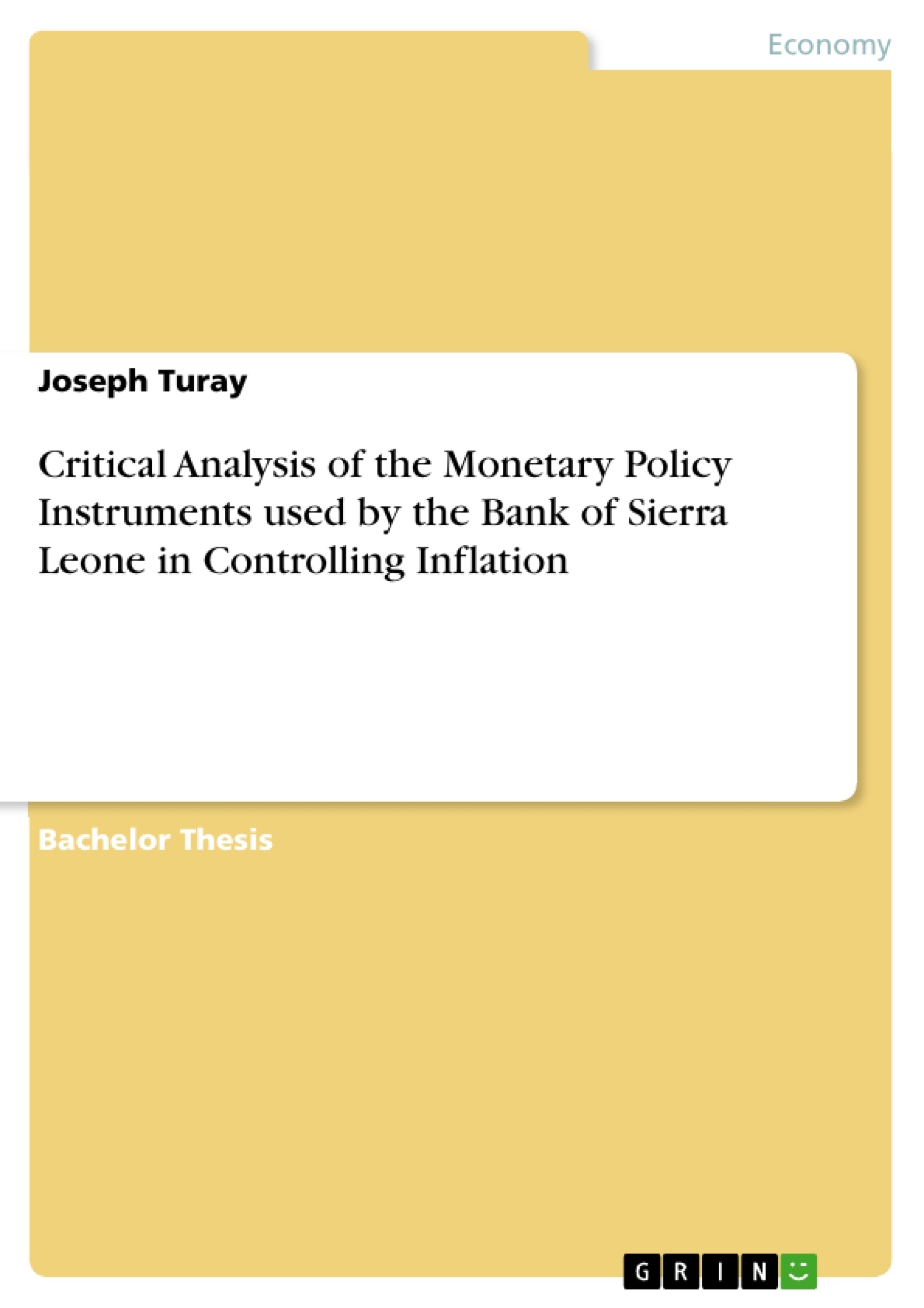This study seeks to assess the impact of the monetary policy instruments used by the Bank of Sierra Leone in controlling inflation for the period of 12 years starting from 2010 to 2021. In a bid to address the objectives of the study, the secondary data collected were analyzed using descriptive statistics, correlation analysis and the multiple linear regressions to test the hypothesis of the study. The study discovered that monetary policy rate, exchange rate and money supply are all having a positive and significant impact in controlling inflation in Sierra Leone. The study therefore recommends that the most appropriate solution to inflation in Sierra Leone is supply management, which entails increase in the domestic production of consumer goods to meet the ever-increasing consumer effective demand.
Inhaltsverzeichnis (Table of Contents)
- ABSTRACT
- CHAPTER ONE
- 1.0 Introduction
- 1.1 Background of the Case Study
- 1.2 Statement of the Problem
- 1.3 Objectives of the Study
- 1.4 Research Questions
- 1.5 Statement of Hypothesis
- 1.6 Significance of the Study
- 1.7 Scope of the study
- 1.8 Delimitation of the Study
- 1.9 Definition of Terms
- 1.10 Organization of the Study
- 1.11 Summary
- CHAPTER TWO LITERATURE REVIEW
- 2.0 Introduction
- 2.1 Theoretical Literature
- 2.1.1 The Classical View of Monetary Policy
- 2.1.2 Keynesian View of Monetary Policy
- 2.1.3 The Monetarist View of Monetary Policy
- 2.2 An Overview of Sierra Leone Monetary Policy
- 2.2.1 Administration of Monetary Policy in Sierra Leone
- 2.2.2 Objective of the Bank of Sierra Leone (BSL) Monetary Policy
- 2.2.3 Instrument of Sierra Leone Monetary Policy
Zielsetzung und Themenschwerpunkte (Objectives and Key Themes)
This dissertation examines the monetary policy instruments employed by the Bank of Sierra Leone in controlling inflation. The study aims to critically analyze these instruments and their effectiveness in achieving price stability. The main objective is to contribute to the understanding of monetary policy implementation in Sierra Leone, particularly in the context of inflation management.- Effectiveness of Monetary Policy Instruments
- Impact of Monetary Policy on Inflation Control
- Historical Evolution of Monetary Policy in Sierra Leone
- Economic and Social Implications of Inflation
- Challenges and Opportunities in Monetary Policy Implementation
Zusammenfassung der Kapitel (Chapter Summaries)
- Chapter One: Introduction This chapter introduces the research topic, providing a background on the case study, outlining the problem statement, and clarifying the research objectives. It details the research questions, hypotheses, significance, and scope of the study. The chapter also defines key terms used in the research and outlines the organization of the dissertation.
- Chapter Two: Literature Review This chapter presents a comprehensive review of existing literature on monetary policy, focusing on theoretical perspectives, historical trends, and the application of monetary policy in Sierra Leone. It examines the Classical, Keynesian, and Monetarist views of monetary policy, providing a theoretical foundation for the study. The chapter also explores the administration, objectives, and instruments of Sierra Leone's monetary policy framework.
Schlüsselwörter (Keywords)
This study focuses on monetary policy instruments, inflation control, Bank of Sierra Leone, Sierra Leone economy, monetary policy objectives, price stability, economic growth, and financial stability.- Citation du texte
- Joseph Turay (Auteur), 2022, Critical Analysis of the Monetary Policy Instruments used by the Bank of Sierra Leone in Controlling Inflation, Munich, GRIN Verlag, https://www.grin.com/document/1372394



